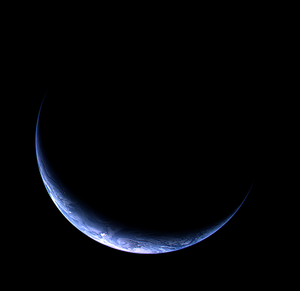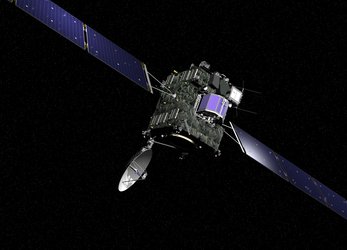ESA spacecraft may help unravel cosmic mystery
When Europe's comet chaser Rosetta swings by Earth tomorrow for a critical gravity assist, tracking data will be collected to precisely measure the satellite's change in orbital energy. The results could help unravel a cosmic mystery that has stumped scientists for two decades.
Since 1990, scientists and mission controllers at ESA and NASA have noticed that their spacecraft sometimes experience a strange variation in the amount of orbital energy they exchange with Earth during planetary swingbys. The unexplained variation is noticed as a tiny difference in speed gained or lost during the swingby when comparing that predicted by fundamental physics and that actually measured after the event.
Tiny unexplained speed variations
The unexplained speed variations are extremely small: NASA's Galileo satellite experienced an increase of just 3.9 mm/s above the expected value when it swung past Earth in December 1990. The largest unexpected variation - a boost of 13.0 mm/s - was observed with NASA's NEAR spacecraft at its Earth swingby in January 1998. On the other hand, variations seen at the swingbys of NASA's Cassini in 1999 and Messenger in 2005 were so small that they lay within the bounds of uncertainty.

ESA's Rosetta has made two Earth swingbys, in 2005 and 2007. It too, experienced the strange anomaly. Frustratingly, Rosetta sped up by an unexplained 1.8 mm/s during the first passage, but experienced no slowing or speeding in 2007. No one knows what will happen on 13 November 2009 for Rosetta's third and last Earth swingby: scientists are stumped.
"It's a mystery as to what is happening with these gravity events. Some studies have looked for answers in new interpretations of current physics. If this proves correct, it would be absolutely ground-breaking news," says Trevor Morley, lead flight dynamics specialist working on Rosetta at ESOC, ESA's European Space Operations Centre, Darmstadt, Germany.
ESA researchers study Rosetta
Together with ESA colleague and orbital mechanics specialist Frank Budnik, Morley co-authored a scientific report in 2006 that studied the Rosetta anomaly during the 2005 swingby and listed possible causes.
These range from tidal effects peculiar to the near-Earth environment, atmospheric drag, or the pressure of radiation emitted or reflected by the Earth, to much more extreme possibilities, such as dark matter, dark energy or previously unseen variations in General Relativity, one of the most fundamental and well-tested theories of modern physics.

One American research team, led by ex-NASA scientist John Anderson, is even looking at the possibility that Earth's rotation may be distorting space-time - the fundamental fabric of our Universe - more than expected, thus affecting nearby spacecraft. But there is as yet no explanation how this could happen.
Before even considering such exotic explanations, all the usual causes of spacecraft speed errors have been thoroughly eliminated by numerous investigations conducted over the years at both ESA and NASA. Software bugs, calculation errors, tracking uncertainties and other, much more mundane, causes have all been systematically eliminated or accounted for, leaving the speed anomaly maddeningly unexplained.
NASA's Pionneer 10 & 11 similarly affected
As it stands now, no one knows what's behind this - it really is a mystery.
Scientists at a number of universities and research centres in Europe, the US and Japan have worked on the anomaly problem over the past years. The Earth swingby anomaly has been compared to another unexplained anomaly - one experienced by NASA's Pioneer 10 and 11 spacecraft.
As they travel on trajectories that will take them eventually into interstellar space, both have experienced an unexpected acceleration directed toward the Sun, which has yet to be explained.
Watching through the night
At ESOC on 13 November, the mission control and flight dynamics teams will be watching closely as ESA's 35m New Norcia station in Australia tracks Rosetta during the closest approach, expected at 08:45:40.0 CET, followed - after a visibility gap of 20 minutes - by ESA's 15m Maspalomas station.
The tracking activity will generate highly precise data that will record whether the spacecraft speeds up or slows down more or less than expected. Deep space ground stations operated by NASA, at Canberra, Australia, and Goldstone, California, will also observe the spacecraft before and after closest approach.

"We are using as many ground stations as are available to maximise the amount of swingby data we record. The more data we get, the better the chance that we may eventually come up with an answer," says Morley.
The data is keenly awaited by scientists on a number of continents, who are hoping to see whether the anomaly is present and whether an explanation is finally possible.
"As it stands now, no one knows what's behind this - it really is a mystery. And your prediction as to whether Rosetta will experience any swingby speed anomaly at all on 13 November is as good as anyone's," says Morley.















 Germany
Germany
 Austria
Austria
 Belgium
Belgium
 Denmark
Denmark
 Spain
Spain
 Estonia
Estonia
 Finland
Finland
 France
France
 Greece
Greece
 Hungary
Hungary
 Ireland
Ireland
 Italy
Italy
 Luxembourg
Luxembourg
 Norway
Norway
 The Netherlands
The Netherlands
 Poland
Poland
 Portugal
Portugal
 Czechia
Czechia
 Romania
Romania
 United Kingdom
United Kingdom
 Slovenia
Slovenia
 Sweden
Sweden
 Switzerland
Switzerland









































